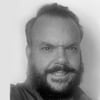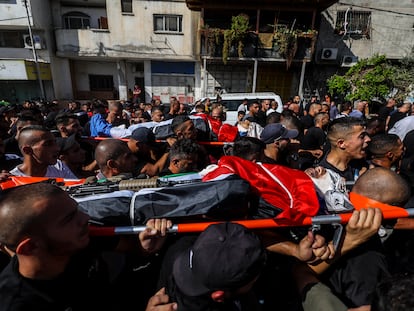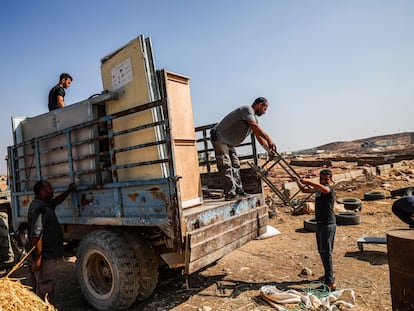War in the shadow of the Israeli wall in the West Bank: ‘It’s as if I hadn’t left prison’
The 708-kilometer long barrier has left residents’ homes surrounded by Israeli settlements and makes it difficult for Palestinians to access their lands
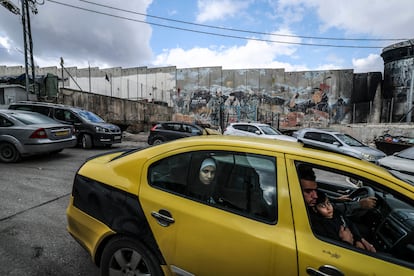
“I still keep it with the blood stains.” Yaser Abdelgafar takes the shirt he was wearing on October 16, 2000 out of his bedroom. That day, at 3:00 in the afternoon, an Israeli bullet burst through the head of Moayad Jawaresh, a 14-year-old neighbor who lived in the Aida refugee camp, next to Bethlehem (West Bank). A soldier shot him from the fortress that then surrounds Rachel’s Tomb, a controversial historical site for Muslims, Christians, and Jews but which Israel has closed to its citizens. Today, the fortified barrier at Bethlehem has been integrated into the more than 700 kilometers of concrete, metal bars, and barbed wire that snakes mostly through Palestinian territory has separated the occupied West Bank from Israel since 2002.
The reason given for constructing the wall was to guarantee security against attacks from those living in the West Bank. The barrier even passes through Jerusalem, isolating Palestinian East Jerusalem from the rest of the city. In 2004, the United Nations International Court of Justice considered it illegal. With the passage of time, the barrier has turned it into a tool that, in times of war like the one that began on October 7, allows the ring around the Palestinian territory to be further tightened and therefore control and usurp the land of the encircled Palestinians. EL PAÍS has visited several points along the West Bank barrier, a scar that remains two decades after it was built.
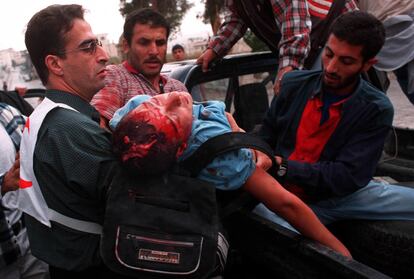
It was a Monday afternoon when Moayad Jawaresh, still wearing his school uniform and carrying his backpack, was shot dead on his way home. At that time the Second Intifada (the Palestinian revolt against Israeli occupation that took place between 2000 and 2005) was in full swing, and children often threw stones at Israeli soldiers on the streets. Yaser Aldelgafar and other adults, including members of the Red Crescent, collected Moayad’s lifeless body and transported it to the hospital.
Abdelgafar remembers the exact point, at the entrance to the Aida refugee camp and just a few meters from where the looming gray monster stands today. The wall, a dozen meters high and crowned with barbed wire, is full of protest slogans and graffiti. There are even some examples of Banksy’s subversive art, although these days tourists don’t see that.
Even after 23 years, Moayad Jawaresh is considered a “martyr” of the Palestinian cause and his name is still spoken in Aida. However, his mother Iman is afraid to speak. Besides the construction of the wall, little has changed. Teenagers today are still being shot like the generation of adolescents who lived during the Second Intifada. The last death was Mohamed Azeha on November 10. His image appears on numerous posters on the walls of the motley network of alleys that make up the refugee camp. Like Moayad, Mohamed died as a result of a bullet fired from the wall.
Likewise, 14-year-old Abdallah Saquer was wounded on November 1 when a bullet pierced his right leg at thigh level. The young man winces with pain as he enters his bedroom with the help of his mother Ataf. He leans awkwardly on crutches. “We were playing in front of the turret and there was a sniper. Someone threw stones at him, he responded with live rounds,” he says. His mother remembers the times before the wall when she could go to the surrounding fields to get olives or go shopping in Jerusalem, whose city limits are just over a mile away.
Abdallah is not sure what he wants to do as an adult. He settles for working as a merchant in a small food business like the one his uncle has in the Aida refugee camp. While he talks, his taciturn older brother Ahmed arrives. The 16-year-old is also injured and on crutches. In his case, according to the story he can corroborate with photos on his mobile phone, a bullet caused significant damage to his right foot in mid-October when he was riding his electric bicycle near a military checkpoint in the town of Al Khader, also in the Bethlehem area.
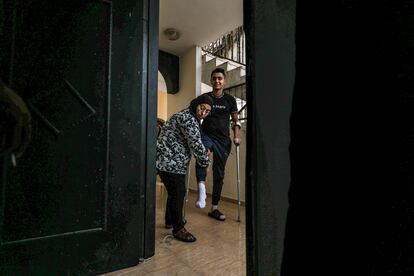
“It’s as if I hadn’t left prison,” Ali Abu Aker laments as he looks out from the roof of his house in front of the wall. After nine years in Israeli prisons, he returned to Aida last March. He does not want to discuss the reasons for his imprisonment and claims that he simply pushed some Israeli soldiers who were harassing his father-in-law. What is clear to him is that he has not regained his freedom.
To the right, the tower the neighbors claim the shots come from stands embedded in the wall. Occasionally, the huge gate opens and several vehicles enter the camp from the other side to carry out a raid and arrest people. The last time was ten days after the war in Gaza began. It has happened almost daily in other places in the West Bank, where violence has skyrocketed since the October 7 Hamas attack on Israel. Since then there have been 200 Palestinian deaths and around 3,000 people detained in the West Bank.
From his home, Ali Abu Baker can still see some olive groves on the other side of the barrier. Young Mohamed and Yaser pick olives there, but due to the road closures imposed during the war, they have to make a detour of almost an hour and pass through several military checkpoints to reach them. One of the roadblocks on a road shared by Jewish settlers and Palestinian citizens was attacked by three Hamas militiamen last Thursday — the day after this newspaper’s visit to Aida. The three militants were killed by gunfire from the Israeli security forces, one of whose soldiers died that same day from his wounds. A few yards from the scene of the incident, there are gaps in the wall, which has not achieved the impermeability that Israel wants.
Its layout was largely marked by the location of illegal settlements in the West Bank, where around half a million Israeli settlers live. Thus, it laid “the groundwork for the de facto annexation of most of the settlements and much land for their future expansion,” according to the Israeli human rights NGO B’Tselem. The organization estimates that through constructing the barrier, Israel absorbed around 10% of the West Bank — an area of about 5,700 square kilometers (2,200 square miles).
“The colonies are like a cancer that is constantly eating away at us,” Yaser Abdelgafar says to illustrate the growth of these communities. The Israeli government, especially the current Prime Minister Benjamin Netanyahu, has encouraged these illegal settlements, whose security and well-being is paid for by inconveniencing the Palestinian residents.
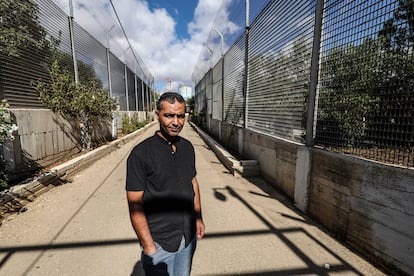
Very close to Jerusalem, Saadat Ghryib shows us his home in the West Bank town of Beit Ijza, which is officially in Palestine. While three of his four children run around, he lets visitors pass through the electronic gate, controlled by the Israeli security forces, and walk along a 30-meter corridor to reach his house.
The construction of a plant emerges as an anomaly that has been engulfed by the regular street layout of the Givon Hahadasha settlement. They live cheek by jowl but they do not mix. This close separation is controlled by twenty cameras that monitor the Palestinian family 24 hours a day. The Ghryibs’ house is confined by a high metal palisade that separates their home from the adjacent chalets. Only five or six meters away the settlers live among Israeli flags fluttering in the wind.
Saadat’s neighbors whose names he does not even know have shouted at him: “What is happening in Gaza is going to happen to you if you do not leave this land.” They point guns at his family, they scold them and they are suspicious of any movement that the family makes after sunset, he says, reflecting the atmosphere of tension caused by the war in Gaza. “We are victims of the army’s aggression every time something happens, whether it is in the West Bank or in Gaza. They harass us, they attack us…” he adds.
Saadat’s father Sabri Ghryib, who died in 2012, refused to sell the family’s 10 hectares when settlers pressured him to set a price for them, starting in 1979. “They came with a lot of money,” but “he said he was not going to part with a single hectare,” says Saadat.
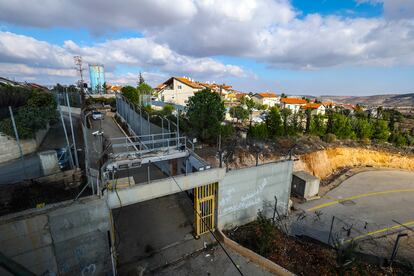
After years of what they describe as a hell of attacks and pressure they were unable to stop despite winning in the Israeli courts, the family was left with no money and only four of the 10 hectares. The rest was “stolen” by the settlers, according to Saadat. Sabri Ghryib visited the then Palestinian president, Yasser Arafat, on more than one occasion to give away his properties to prevent the plunder, but he was engaged in negotiations with Israel and avoided the issue, according to Saadat.
Later came the wall, which ended up separating them from the other six hectares, whose olive harvest they depend on. The culmination was the imprisonment in 2006 of Sabri Ghryib and his two children. When they returned home after four months, the Israelis had fortified the corridor around the house. In 2008, they equipped the passage with an electronic gate that can lock them at home if the security forces decide. But they are not alone with this problem. Beit Ijza is one of the 150 Palestinian towns whose residents the barrier was designed to separate from their fields.
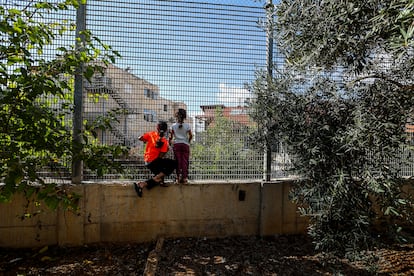
The family is not suffering the arbitrariness in issuing the permits to take a 45-minute detour to reach their six hectares to harvest the olives. The permit has simply been revoked in the shadow of the conflict between Israel and Hamas. “That means losses for us of about $7,000,” Saadat says.
His 11-year-old son Sabri enters the room and bows, bowing his head into his father’s hand as a sign of respect. Seconds later, he takes his cell phone and switches off from the conversation in which it becomes clear that he, as a member of the Ghryib family, will also inherit the problem of the occupation. “The Israelis’ plan is for us to leave, but we will not move one inch from this land. Even if they close the gate and it is our last day, we are not going to leave,” says Saadat Ghryib.
Sign up for our weekly newsletter to get more English-language news coverage from EL PAÍS USA Edition
Tu suscripción se está usando en otro dispositivo
¿Quieres añadir otro usuario a tu suscripción?
Si continúas leyendo en este dispositivo, no se podrá leer en el otro.
FlechaTu suscripción se está usando en otro dispositivo y solo puedes acceder a EL PAÍS desde un dispositivo a la vez.
Si quieres compartir tu cuenta, cambia tu suscripción a la modalidad Premium, así podrás añadir otro usuario. Cada uno accederá con su propia cuenta de email, lo que os permitirá personalizar vuestra experiencia en EL PAÍS.
¿Tienes una suscripción de empresa? Accede aquí para contratar más cuentas.
En el caso de no saber quién está usando tu cuenta, te recomendamos cambiar tu contraseña aquí.
Si decides continuar compartiendo tu cuenta, este mensaje se mostrará en tu dispositivo y en el de la otra persona que está usando tu cuenta de forma indefinida, afectando a tu experiencia de lectura. Puedes consultar aquí los términos y condiciones de la suscripción digital.
More information
Archived In
Últimas noticias
Most viewed
- Sinaloa Cartel war is taking its toll on Los Chapitos
- Oona Chaplin: ‘I told James Cameron that I was living in a treehouse and starting a permaculture project with a friend’
- Reinhard Genzel, Nobel laureate in physics: ‘One-minute videos will never give you the truth’
- Why the price of coffee has skyrocketed: from Brazilian plantations to specialty coffee houses
- Silver prices are going crazy: This is what’s fueling the rally
